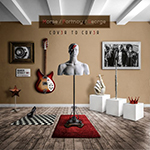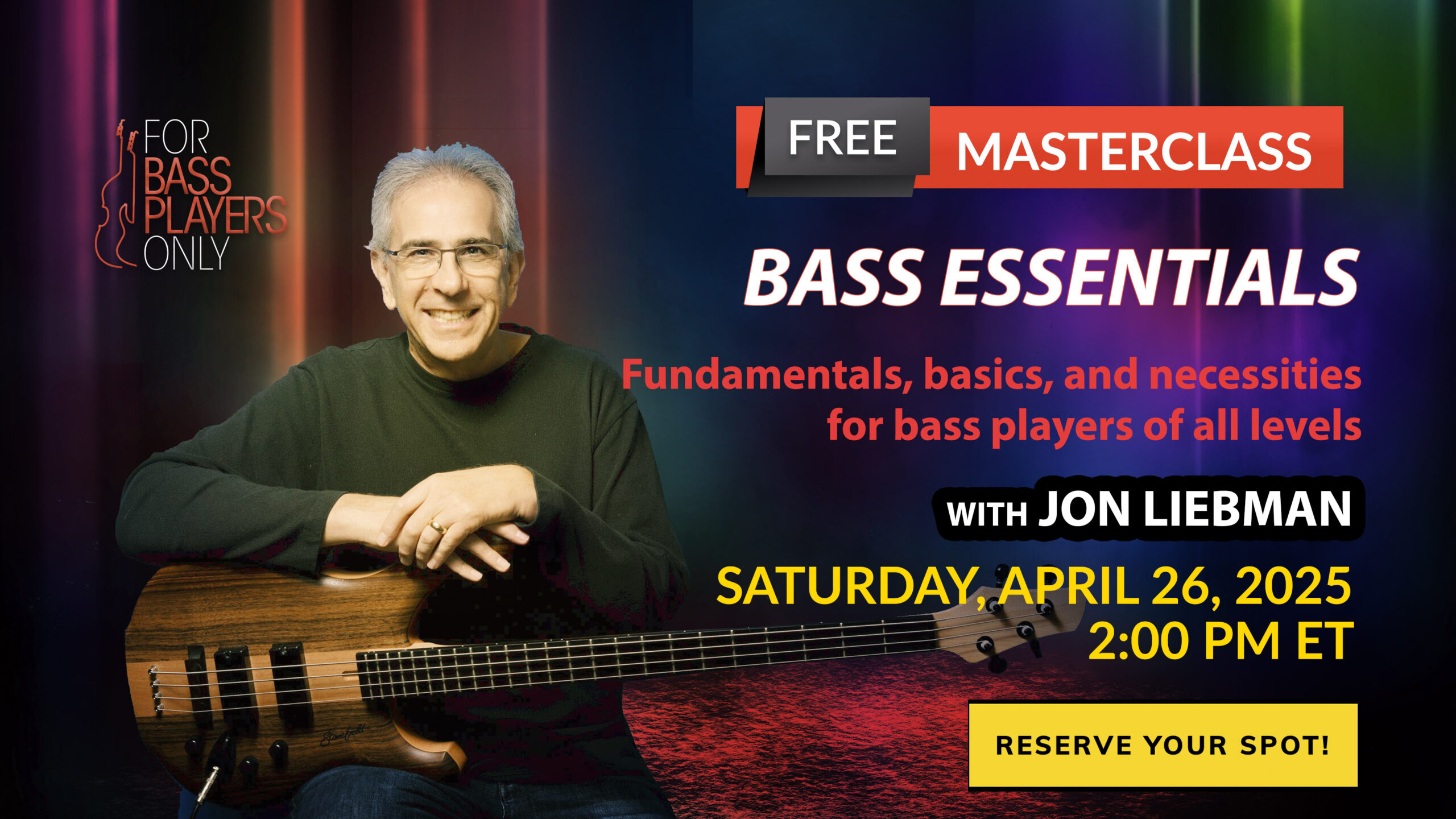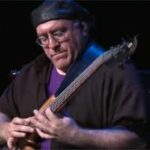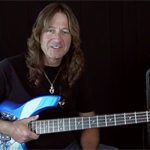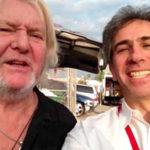All the scoop on the latest compilation of classic covers, recorded with Neal Morse, Mike Portnoy
Exclusive interview with FBPO’s Jon Liebman
July 27, 2020
Colorado native Randy George is an in-demand bassist, multi-instrumentalist, arranger, and producer. Randy, a longtime member of the Neal Morse Band, has also performed and/or recorded with the likes of Rick Wakeman, Michael Manring, Jordan Rudess, Paul Gilbert, Steve Hackett, Adrian Belew, and many others. His most recent project is a third collection of cover tunes recorded with Neal Morse and drummer Mike Portnoy, titled Cov3r to Cov3r, released on July 24.
FBPO: The last time we did an interview was in 2017, right after The Similitude of a Dream had come out. I can’t believe it’s been three years.
RG: Yeah, time flies, huh?
FBPO: Yeah. Congratulations on the new record Cover to Cover #3. I’ve been listening to it almost nonstop. I can’t get enough of it.
RG: Awesome!
FBPO: I guess my first question would have to be, how did you go about picking the songs? Every one of them is just a classic. You took me right back to the years when I was growing up, and all the stuff that was on the radio, and all the stuff that I enjoyed so much.
RG: We’ve done three of these now, and usually they’re at the tail end of an album tracking session, so pretty much all we do all week is talk about which covers we’re going to play. And ultimately, it comes down to which ones we can all agree on. That’s always how it’s been. This time, a little different. Mike was tracking the Transatlantic record, so we planned to do this in the wake of that session. I wasn’t really there and I think, because they ran long on the Transatlantic material, he didn’t have as much time for covers as first thought. I think it was lot of finding covers Mike knew pretty well already, and I think he and Neal sorted it out together. I threw out “Baker Street,” but yeah, Mike will come up with things like the Yes thing. I’m sure that was Mike’s idea. “It Don’t Come Easy,” he wanted to do the Ringo tribute. The Lenny Kravitz thing. Neal wanted to do the Squeeze songs, and “Baby Blue,” and “Life on Mars,” things like that. Everybody sort of has their song, and it’s what we can all agree on, really. If everybody’s like, “Yeah, I’ll do that,” then that’s the song that gets put on there.
FBPO: In the last interview, you cited The Moody Blues and The Monkees as being among your influences. Did that have anything to do with the songs from those bands that ended up here?
RG: Well, sure. Yeah. Not so much The Moody Blues, because we didn’t really cover any Moody Blues. I think Neal covered “Tuesday Afternoon.” Or that might’ve even been Mike’s idea. But in any case, he did that back on Testimony, so that was just pretty much him and Mike. But yeah, as far as the Cover to Cover series, Monkees, yeah, that came up right at the very first one, the idea to do “Pleasant Valley Sunday.” And of course it was Neal’s idea to do a different take on it. In any case, Neal and Mike, they like to bang them out and be done with them. They don’t really want to spend a lot of time fussing over doing a cover song.
FBPO: Just have fun, huh?
RG: Yeah. It’s mostly, “Let’s get it done.” And it is what it is. In some cases, I think it’s been as good or better than the original. And in most cases, they’re nice covers. You never really replace the originals, but yeah. That’s an era I grew up with. That was my childhood. But Neal, Mike, and I, we sort of intersect there, because it was the same for them.
FBPO: It sounds like, for the most part, the writing and the arranging stayed pretty true to the original songs.
RG: Yeah, most of the time.
FBPO: And there are some nice bass lines. There’s a triplet run thing you do in “Tuesday Afternoon.” And in “Badge,” which has such an iconic bass line. You held true to the original, but you also took some liberties, which I enjoyed very much.
RG: Sure. My first inclination is always to approach an original, trying to recreate the sound of the original. For some people, it doesn’t even make sense. If you’re going to do it and cover it, you might as well do something different with it. One case is “No Opportunity Needed, No Experience Necessary,” by Yes, which was a Richie Havens song. They didn’t write it, but nobody would really know that song as popular as Yes made it. Nobody would have known that it was a cover, or that they were borrowing from a local theater play soundtrack. It’s interesting how a song can be covered and still be its own thing. In that era, a lot of bands made somebody else’s song popular in a way that it would never would have been. That stuff’s cool in the case of a song like that.
FBPO: You’re reminding me of Joe Cocker. When he covered a song, he made it very much his own. You knew it was somebody else’s song, but he definitely put his own take on it.
RG: When we did “The Letter,” Neal and Mike totally wanted to do the Joe Cocker version. That was totally where their heads were at. And I’m like, “I’d rather do The Box Tops’ version.” That would have been the version I would’ve gone for, just because it’s got that ’60s surf vibe, you know?
FBPO: So this band is called Morse Portnoy George?
RG: Yeah. We just used our names, Morse, Portnoy, and George. I guess when we did the first cover album, we had already … we pulled some covers, done on, oh, I guess across three different album sessions. Some of those on the One bonus disc. A couple of were on the Testimony bonus disc. Then we had done a bunch more. And I said, “Well, let’s just take this new batch of covers, and call all the old ones,” there was like a half a dozen, “and we have enough for a cover CD.” Neal was reluctant at first, but Mike and I talked him into it. And I think Mike suggested, when it came out, that we call it Morse Portnoy George, because it’s the three of us, just covering songs. There wasn’t any point standing on tradition or trying to be clever with a name, just, it’s us, here’s the songs.
FBPO: There you go. Who else is on the record, outside of you three?
RG: On this record, it’s odd that there were a number of departures from what we would have done in the past. Of course any brass that you hear is the usual brass guys that we’ve always used. Jim Hoke is the sax player. Then he did the part on “Baker Street,” as well as the “One More Red Nightmare.” Then there was three-piece brass on the Ringo song, “It Don’t Come Easy.” And there might’ve been some others. With the Yes cover, and I kind of suspected this, Neal probably just went along with it. Mike’s the one that wanted to really do that song. And Neal, I am sure Neal knew there wasn’t really any way he was going to be able to cover it. I think he was willing to give it a shot, but it really was just so not in his range. It’s too far out of his element. That’s when we decided we’re going to go for a guest singer. And we actually asked Jon Anderson if he wanted to do it, and took a couple of weeks to get a reply out of him. But he politely declined. So we asked Jon Davison, and he was up for it. At that point, Neal, he wanted to do the guitar, and pretty much that was it. He didn’t want to learn all the keyboards and redo all the orchestration stuff. So he asked me if I wanted to do it. And I said, “Well, it’s not really … I could, but I’d rather get somebody better.” So they were okay with it, and I got my keyboard player, Jonathan Sindelman, from several of my projects, to put it together. He’s very good at recreating sounds, and we’ve played a lot of Yes together over the years. Plus he plays in Alan White’s band, his local band that he has in Seattle. That’s how we arrived at that. I had my wife do the background vocals. He also asked me if I wanted to do the keyboards on “Baker Street,” so I did all the keyboards on “Baker Street,” except for the organ. He did the organ part, but that’s just mostly a rhythm bed.
FBPO: How much touring did you guys do, before this whole Corona thing hit? Did you do anything on the road at all?
RG: Well, as the Neal Morse Band, we toured the Great Adventure record, which is the follow-up to Similitude. It was another double disc that pretty much continued the same storyline. And it was pretty much the same format in terms of an album. It was a little edgier, overall, a little darker, a little edgier than Similitude. But yeah, we did another 45 dates worldwide, at the beginning of 2019. But Morse Portnoy George, no. We haven’t really ever toured. We’ve done covers on tour, as the Neal Morse Band or whatever. Even as Neal Morse, back in the day. I think we had “Crazy Horses” as part of the encore. Mike came out front and sang, and Neal jumped on the drums. But the trio, as itself, has never actually toured. I suggested doing that for this album. And we probably would be looking at that possibility, probably on a very limited scale. We would’ve done LA, Chicago, New York, at least. Then everything happened, so nobody’s doing anything at the moment, except recording.
FBPO: And you’ve been making the most of the time?
RG: We just took the opportunity to do another Neal Morse album, which he felt to write another epic prog song, backs away, that we used to do it, back in the day, when it was just Neal and Mike and I. But Bill (Hubauer) and Eric (Gillette) both appear on that, too. Yeah, this Cover to Cover thing, we had already decided, like I said, he tracked the drums in December, when he was doing drums for Transatlantic. So we had already planned. This was already in the works before the pandemic hit.
FBPO: What is the status of the Neal Morse album? Is the recording done?
RG: We’ve been working on that for a while. It comes out in September. They just announced the pre-orders or the release, so there’s pre-orders, a video’s coming, but it’s already been … it’s in the can. Yeah.
FBPO: What’s it called?
RG: Sola Gratia.
FBPO: Tell me about your gear.
RG: Basically, I’ve used the same setup for a long time, probably since 2004, 2005, somewhere right in there. SansAmp has been one of my mainstays. When I tracked … like when I tracked a Neal Morse album, it’s pretty predictable. It’s pretty much I know exactly what I’m going to do, because it’s what I’ve always done, and it’s the sound, period. So you kind of stick to that.
FBPO: What about basses?
RG: That would be my Spector five-string. It’s an NS-JH5, made in 1999. It’s a very unique bass. It’s a magical piece of wood, as we say. It’s one of those guitars that just has the right tonal properties in the wood, everything resonates, and it’s working on a … it gives it a sound, a sound that you try to find in another bass and you never do. It’s one of those kinds of things. However, doing Cover to Cover 3, these are not songs that really have that sound so much, when they were recorded originally. So I try to stay true to the vibe of how the song was originally recorded. So for a lot of the songs with Cover to Cover 3, I actually used my Wilkins ’65 period correct P-bass, and had had flatwound strings for a lot of the songs, because that was the sound. I really enjoyed doing that. It’s a sound that I’m just very used to hearing in these songs, so it was fun to recreate it, and kind of interject that.
FBPO: What else did you use for this record?
RG: With the songs like Yes and King Crimson, I used a Rickenbacker for the Yes song, and I used the Wilkins P for King Crimson, but I put roundwound strings on. And then I made it really gnarly and brutal-sounding.
FBPO: How did you approach the recording process?
RG: The way I do that, basically, is … right now, how I’m recording is I’m usually dumping four tracks down. One that will be the traditional, SansAmp, DI, bass DI. Then another track will be this Avalon U5, and it’s a straight dry track, with no effect at all. It’s just dry. Then I use the Geddy Lee SansAmp, so I have two channels coming out of that, the dry and the deep. And the deep is a nice, chunky, fundamental, in-your-face bass, without being overly distorted or whatever. And the dry channel’s where you have more of your distortion and grit, that you can control. So between the four tracks, I can really make it sound very brutal, or I can clean it up and make it sound very dated, like they used to, in the day. Yeah, it’s fun, doing that. Basically, except for the dry track, through the Avalon, my live rig is pretty much the same thing. I just always run a SansAmp. I’ve typically, in the past, run the SansAmp DI out, just out of my pedal board, straight to the front of the house, split off a DI box. And then I run a cable to the amp. I can hear it through the amp if I didn’t have in-ear monitoring, but these days, the amp, he mics it, maybe to get some mid-range, I don’t know. It’s mostly ineffective anymore, having a bass amp on stage. It doesn’t really do anything for me or my sound.
FBPO: Sign of the times.
RG: Next time I go out, I most likely will not even have any bass amp on stage. I’ll pull a Geddy Lee, maybe bring out a chicken roaster or something, but it’s gotten to the point where I don’t need that. Now, what I do in my current recording setup, with the Geddy Lee SansAmp integrated, I have the same thing on my pedalboard, where I can run a feed, which is basically, like I said, a fundamental, basic, tough bass sound that’s fairly clean, but it’s got a little bit of saturation to it. And that will be in the mix on one fader at all times. And then my pedalboard will be the other channel that’ll be coming into the mixer, and that has all the effects, the other SansAmp, the brightness, the distortions, the overboard … whatever, all my compression, delay, chorus, anything that I’ve got on my pedal board will come in through that other channel. So there will be a blend of the two at all times.
FBPO: I think you told me once that when you do use an amp, it’s usually an Ampeg, is that right?
RG: Well, my sound happens before it ever gets to the amp, and you’re not really hearing the amp in the mix anyway.
FBPO: Yeah, that’s true.
RG: I think it was always just Ampegs. I don’t know, Dave LaRue got me started on these SVT-4PROs, and he hooked us up with the Ampeg, and Neal and I both bought a rig kit at artist pricings, basically. And it was a good deal and everything. And we would just … I don’t know. After a few years of using it, quite honestly, Ashdown would be my first choice of amp to go to, if I’m really going to count on the sound of an amp. I’ve never had better luck than I have with Ashdown. And in the Europe side of things, I usually take out an Ashdown rig.
FBPO: How about strings?
RG: Well on the Spector bass, I use DR, those DR Hi-Beams, 45 through 125. Those are the only strings that work on that bass. I was on tour in Scandinavia, I think in 2017, for a second round of Similitude, and I ran out of strings, and we went shopping, but we couldn’t find them. They didn’t exist in that part of the world for some reason. They carried DR strings, just not the Hi-Beams. So here I’m trying a bunch of different sets, and we couldn’t get anything that even sounded close. The Rotosounds are really cool. They had a different, darker vibe. I might try those sometime. But yeah, these DR Hi-Beams, and the Spector bass, and the SansAmp have created a tone that I’ve never been able to replace any other way. And it fits in the Neal Morse band somehow, because there are so many keyboards, and guitars, and layers, there’s a lot of layers of everything. To exist in a mix like that, this is a tone that both cuts and sounds brutal, without being too boomy or getting lost too much in the mix.
FBPO: Yeah, stick with what works.
RG: Yeah.
FBPO: Let’s talk about bass technique. At For Bass Players Only, the number of people learning bass online from us is growing every month. What advice you can impart to somebody who wants to learn bass?
RG: Well, I’d say that the one thing that helped me more than anything is I understood music theory. It’s not that hard to learn, but it’s a good tool to be able to look at your bass and understand the relationships of all your notes to each other. You can hear … you can just listen to a song, and you know the chord progression goes one, six, four, five … or whatever, you know what I’m saying? And it doesn’t matter what key, because I understand the theory of it. It’s really easy to zero in on what you’re hearing if you understand a little bit about the notes and why the music works the way it does. Now, that’s a little more academic, but I think that knowledge will serve you a lot better in the future than just about anything else.
FBPO: Anything else?
RG: I can tell you something like, “Make yourself stand out.” I think when I was younger, some of the coolest advice I ever heard from an artist was, “Make yourself stand out.” Good old Bootsy Collins advice. Do something that makes you stand out. I started wearing really colorful, ornate shirts in the Neal Morse band, because at first, it was like seven, eight people on stage, I’d be in the back. And I don’t know. Prog is known for colorful outfits, so it’s just one of those things. You find a way to make yourself stand out, and just be the best player that you can be, and be willing to listen to other people, and what they’re saying, and try to serve their music without your own ego getting in the way. That’ll go a long way. That doesn’t mean you won’t be able to be you. It just means that you can forge strong relationships with other musicians, who will encourage you to play better. And when you play with people who are way better than you, it pushes you. I had to learn a lot of really hairy stuff from Neal Morse, because he writes all this stuff on keyboards. So it’s a whole different thing. You’re trying to play it on a bass or a guitar, so it requires you to learn, and be a lot more aggressive about what kind of player that you are, and how you see yourself. That’s my bag of advice for today.
FBPO: I like it. Let’s talk about the future. If I may, I’d like to read a quote from our last interview. You said, “I’d really like to do another solo album. I’m thinking about it, and toying around with some other band ideas, as far as trying to do some original stuff with a group of guys.” Anything to report on that front?
RG: Well, the group of guys ended up being me and my wife! And my drummer from LA, who I worked with in my Steve Hackett tribute and the Genesis tribute that I did. Scott Connor, he’s a drummer friend of mine. My wife and I sat and wrote some music. Some of it was music that I’d had sitting around a while, and she started singing to it, and we just forged the vocal ideas, and from that, we were able to dial in a song arrangement. We put four songs together. We were shooting for a whole album, but we managed to get four songs that we thought were pretty solid. We were just starting to get some interest from some other record label and try not to do any crowdfunding. But when the pandemic hit, we felt we should just release the four songs as an EP and see how it does. It’s very different. It’s not quite as heavy as the Neal Morse Band. Some of the reviews really nailed it on the head. Something like, “Somewhere between Fleetwood Mac and Steely Dan, and The Who,” and whatever. I don’t know.
FBPO: What’s it called?
RG: It’s called Sweet Invention – Streaming Out the Day and it’s available pretty much anywhere you like to download music. Yeah. It was just one of those things, where it’s a lot of influences from the ’70s. An album that should’ve been made then, that you’re just now hearing. I think that was how they described it, in this interview.
FBPO: Obviously, you’re still keeping pretty busy, despite the pandemic.
RG: Yeah, the new Neal Morse album is coming out, my wife and I just released an EP, and there’s Cover to Cover 3. And there’s always other Neal Morse stuff going on. The Live in Brno thing came out just a little while ago. I got a lot of records swimming around my head.
See Jon’s blog, with key takeaways from this interview, here.
Cov3r to Cov3r is available here:

